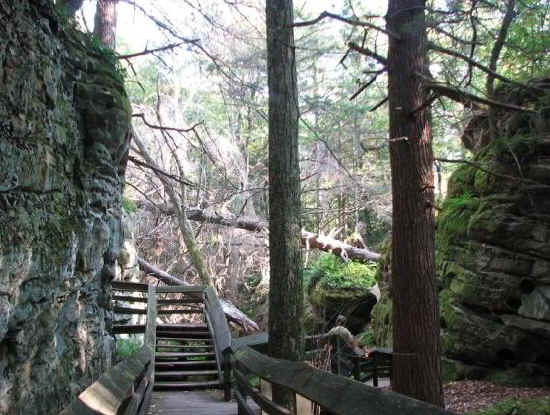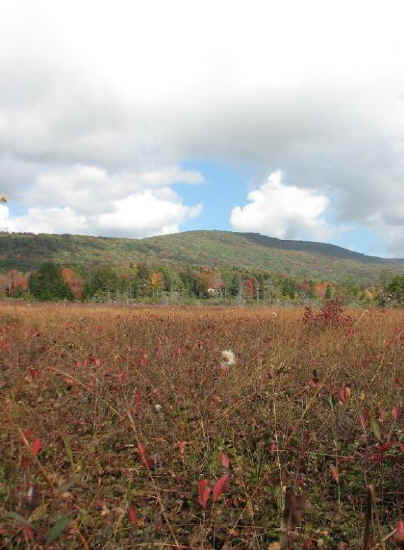|
==============================================================================
TOPIC: West Virginia.
http://groups.google.com/group/entstrees/browse_thread/thread/b9b725065b9e682f?hl=en
==============================================================================
== 1 of 2 ==
Date: Wed, Oct 10 2007 12:36 pm
From: "bob@jamesrobertsmith.net"
Just back from WV. Unfortunately, I did not get a chance to revisit
the old spruce grove on Gaudineer Knob. It was just too far from our
base of operations to fit in a trip. I also was not able to get to
Webster Springs for the same reason.

I did get to take a look (from a boardwalk, as bushwhacking is not
allowed) at the forests at Beartown State Park, which is actually a
107-acre natural area created to protect a series of sandstone
pillars
and old trees. There is (was) an impressive grove of hemlocks there,
but the adelgid has seen to that. The hemlocks there are all but
dead
and will be completely so in a few months, I'd say. I took some
photos
of the living dead hemlock trees and will try to post them for all
to
see later.

Also, we were able to take a similar boardwalk hike through
Cranberry
Glades, which was quite interesting, even in this hideous drought
through which we're suffering. Moisture levels were low even in
these
glades. Many streams in the area had completely dried up, waterfalls
were nothing but cliff faces, and I was able to walk across the
Greenbrier River without getting my feet wet.
I did get a chance to walk through a recovering poplar forest in
Watoga State Park--a forest last logged, depending on the area,
between 70 and 100 years ago. Lots of very tall poplars. Curiously,
I
stumbled upon a wide swath in this forest that looked as if it had
been cleared for a powerline, but no powerline around or near, and
the
canopy completely closed over the narrow corridor and only natural
forest floor and leaf litter below. I've never seen this before.
I don't know why I bother to mention this anymore, but I will. The
adelgid has pretty much infested and wiped out the hemlocks all
around
the area of Pocahontas County.
==============================================================================
TOPIC: Beartown State Park photos.
http://groups.google.com/group/entstrees/browse_thread/thread/f07782ee2f850f59?hl=en
==============================================================================
== 1 of 1 ==
Date: Wed, Oct 10 2007 3:34 pm
From: "bob@jamesrobertsmith.net"
== 2 of 2 ==
Date: Wed, Oct 10 2007 12:59 pm
From: "Will Blozan"
James,
Sounds like Beartown State Park could have reasonably saved all
their
hemlocks with a little forethought and stewardship. Why do small
parks like
this let their hemlocks die? I'd like to hear their excuse.
Will
==============================================================================
TOPIC: West Virginia.
http://groups.google.com/group/entstrees/browse_thread/thread/b9b725065b9e682f?hl=en
==============================================================================
== 1 of 8 ==
Date: Wed, Oct 10 2007 1:43 pm
From: "bob@jamesrobertsmith.net"
It's a site shared by the state of WV and...The Nature Conservancy.
So
goes their "stewardship".
== 2 of 8 ==
Date: Wed, Oct 10 2007 5:08 pm
From: "Will Blozan"
James,
Thanks for the picture link. What a cool place! The one close-up of
a
hemlock crown looks somewhat like recovery growth from an
insecticide
treatment (stem injection I would guess). Are you sure no treatments
have
been done?
Will
== 3 of 8 ==
Date: Wed, Oct 10 2007 5:42 pm
From: "bob@jamesrobertsmith.net"
Nope. Not sure. Leave it to a professional arborist to see the
details
I missed. I do know that at some sites, the state of WV has been
aggressive in treating with imadacloprid. It's possible they treated
this grove. I'll write the park and ask.
== 4 of 8 ==
Date: Wed, Oct 10 2007 5:53 pm
From: "Edward Frank"
James and Will,
A copy of the 2006 Hemlock Wooly Adelgid Survey by Karen Kish. West
Virginia
Department of Agriculture.Plant Industries Division,Cooperative
Forest
Health Protection Program. reads:
In the fall of 2004, the WVDA initiated a suppression program to
treat high
value and high visibility infested hemlocks with the systemic
insecticide
imidacloprid. A combination of soil and stem injection methods were
used
depending on soil conditions and proximity to water sources. Merit
75WSP
was injected into the soil around infested trees with a Kioritz soil
injector. IMA-jet was injected into the trunks using the Arborjet
Tree IV
system.
The HWA suppression program was continued in 2006. During spring and
fall
treatments, approximately 532 trees were treated at Audra State
Park,
Babcock State Park, Beartown State Park, Berwind Lake WMA,
Blackwater Falls
State Park, Camp Creek State Park and Forest, Canaan Valley Resort
State
Park, Cathedral State Park, Droop Mountain Battlefield State Park,
Holly
River State Park, Kumbrabow State Forest, Panther State Forest, Twin
Falls
Resort State Park and Watoga State Park.
The 2007 report also says hemlocks were treated at Beartown State
park, but
I have no information on how many.
Ed Frank
-
== 5 of 8 ==
Date: Wed, Oct 10 2007 6:07 pm
From: ForestRuss@aol.com
Bob:
What you probably encountered was a gas transmission line. West
Virginia is
only second to Texas in the total number of gas wells and gas lines
are
everywhere. Smaller ones that are from 2 " to 10" run
through the woods
everywhere and some of the lines end up with a closed canopy forest
over them. The
large lines that are 30" and larger usually have a 100' wide
right of way but
small local lines can have paths through the woods that are as
narrow as 8'.
Also...those second growth poplar can be very impressive.
If you are ever back to Cranberry Galdes again try the hiking trail
that
circles the glades...along that trail are some of the finest,
tallest and
biggest black cherry trees I have ever seen...but I guess it could
be possible as
the Glades are near the headwaters for the Cherry River.
Russ
== 6 of 8 ==
Date: Wed, Oct 10 2007 6:10 pm
From: ForestRuss@aol.com
Will and James:
I think that something was started at Beartown but I think that
Cathedral
State park is in real trouble.
Russ
== 7 of 8 ==
Date: Thurs, Oct 11 2007 5:52 am
From: "bob@jamesrobertsmith.net"
Actually, I got an email from the folk at Cathedral some time ago
informing me that they had embarked on an aggressive treatment
program
on the forest at Cathedral. I posted the response from them on the
old
ENTS board a few months ago.
== 8 of 8 ==
Date: Thurs, Oct 11 2007 5:54 am
From: "bob@jamesrobertsmith.net"
Here are some photographs from the Cranberry Glades Natural Area,
including a composite shot I took of myself with a 300 year-old
birch
at the end of the boardwalk trail that goes into the glade.
http://community.webshots.com/album/561008790lbxMrt
==============================================================================
TOPIC: West Virginia.
http://groups.google.com/group/entstrees/browse_thread/thread/b9b725065b9e682f?hl=en
==============================================================================
== 1 of 1 ==
Date: Thurs, Oct 11 2007 7:16 am
From: "bob@jamesrobertsmith.net"
That sounds right. Here's a photo I took of it:
http://i59.photobucket.com/albums/g295/jamesrobertsmith/IMG_2605.jpg
|